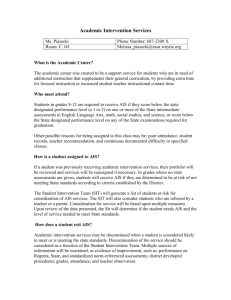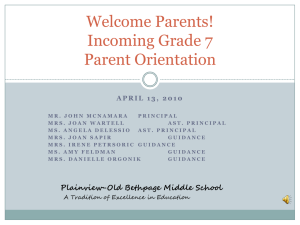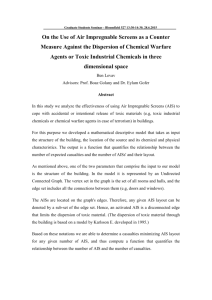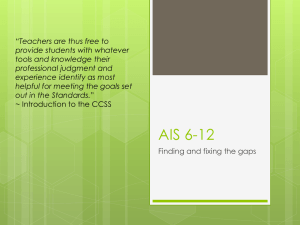RTI Plan - Whitney Point Central School District Home
advertisement
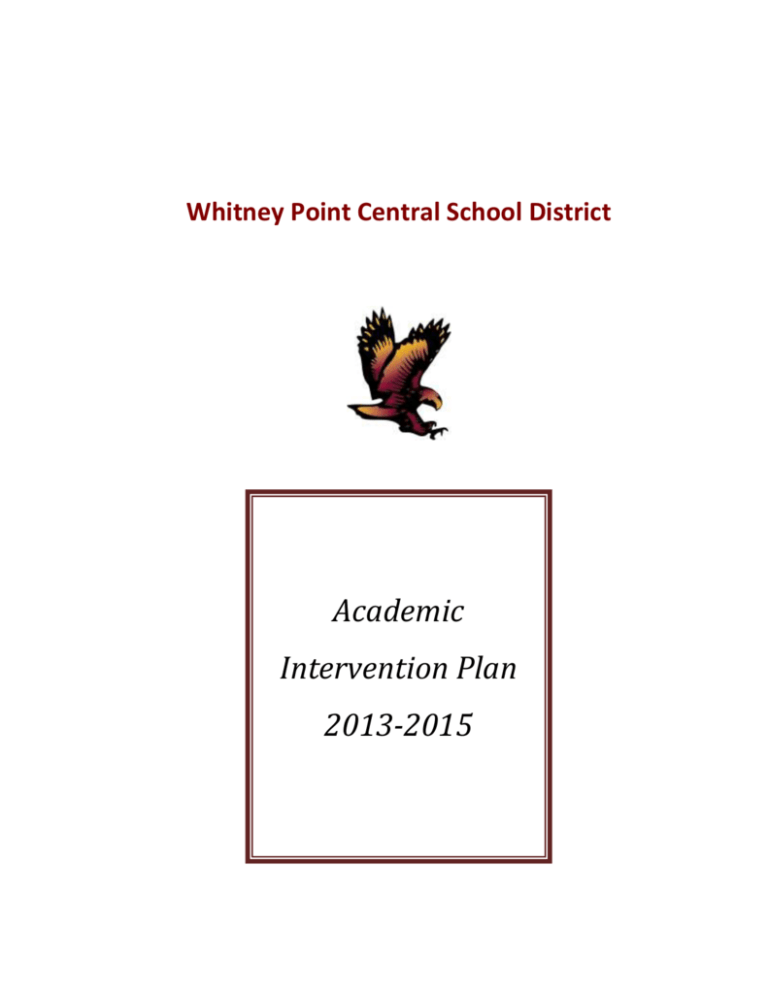
Whitney Point Central School District Academic Intervention Plan 2013-2015 Whitney Point Central Schools Mission Statement: To provide an excellent education ensuring that all children maximize their potential, become contributing citizens, and pursue lifelong learning. District Beliefs: All children possess unique qualities and come to school eager to learn and be successful. We respect all people within our community and treat them with dignity at all times. Learning is a partnership that includes school staff, parents, family and the community. Knowledge allows for critical thinking and effective decision-making. The community is well served by maximizing the use of available resources and by the responsible stewardship of assets. Purposeful and intentional change is a constant that leads to educational improvement and positive results. Compliance with state and federal regulations is critical to school district success. District Vision: To be a community of excellence achieved through a commitment to HIGH performance, morale, and involvement INTRODUCTION In compliance with Commissioner’s Regulations, all public school districts in New York State must submit an Academic Intervention Services (AIS) Plan to be approved by their Board of Education and every two years thereafter. This plan was reviewed and revised with input from intervention teachers, pupil personnel services, and building principals. The goal of our AIS/ RTI services is to help students achieve academic goals expected of the grade level Common Core and NYS standards. All instruction and intervention services are designed to ensure that all Whitney Point Students graduate college and career ready. ACADEMIC INTERVENTION SERVICES Academic Intervention Services (AIS) means additional instruction and/or student support services, which supplement the instruction provided in the general curriculum and assist students in meeting the State learning standards. Academic Intervention Services are intended to assist students who are at risk of not achieving the State learning standards in English Language Arts, mathematics, social studies and science, or who are at risk of not gaining the knowledge and skills needed to meet or exceed designated performance levels on State assessments. Academic Intervention Services shall be made available to students with disabilities on the same basis as non-disabled students, provided, however, that such services shall be provided to the extent consistent with the students’ individualized education plans. Academic Intervention Services include two components: Additional instruction that supplements the general curriculum (regular classroom instruction), e.g. remedial reading or AIS math. Student support services needed to address barriers to improved academic performance, e.g. guidance or social worker counseling services. AIS will be provided to students in English Language Arts and mathematics in grades K-12 and social 2 studies and science in grades 9-12. MULTIPLE MEASURES FOR DETERMINATION OF AIS/RTI SERVICES Grades K-2: Attendance information Report card grades Instructional Support Team recommendation Teacher recommendation(s) Fountas And Pinnell Benchmarking DIBELS Parent recommendation Benchmark assessment results Grades 3-8: Attendance information Report card grades Teacher recommendation(s) State assessment results (ELA, Mathematics, Social Studies, Science) Counseling & Guidance input Parent recommendation Benchmark assessment results Grades 9-12: Attendance information Report card grades Teacher recommendation(s) Regents examination results Counselor input Parent recommendation Benchmark assessment results State assessment results Each year the elementary and intermediate State assessments will have four designated performance levels on each assessment. All students who score at Levels 1 and 2 are mandated to receive Academic Intervention Services. The services for a particular student should vary in intensity based on the student’s needs as measured by the State assessments and other measures of performance. Students with the most intensive needs should receive more scheduled services, for a longer duration with individualized instruction. Students with less intensive needs (those in the upper range of level 2) might only receive student support services such as regular progress checks, additional assessments, and meetings with the classroom teacher to adjust instruction, if necessary. To determine the level of intensity needed by any student who scores below the designated State performance level, districts are advised to review other measures and sources of evidence to determine if a particular score on a State assessment is indicative of that student’s overall level of performance and to determine AIS accordingly. (Multiple Measures) 3 Social- Emotional Support and Intervention Caryl E. Adams (CEA) School psychologist, school social worker, speech Tioughnioga Riverside Academy (4-8) School counselor, school psychologist, social worker, speech, High School (HS) School counselor, shared psychologist and social worker. Academic Interventions Building *Minimal Intensity Tier II Intensity Tier III C. E. Adams Supplemental Instruction with Classroom Teacher Leveled Literacy Intervention Reading Recovery Literacy Intervention Teacher Services Math Intervention Teacher Math Intervention Teacher Literacy Intervention Teacher Services Literacy Intervention Small Group Title I Reading (1-1 or 1-2) Extended Day Extended Day Reading / Writing Wkshp (every other day) Math Support Reading/ Writing Workshop (every day) Math Support Math Tutorial Math Tutorial AIS Global 9 AIS Global 10 AIS US History Extended Day AIS Global 9 AIS Global 10 AIS US History Extended Day English AIS English AIS TRA 4-5 Extended Day Supplemental Instruction with Classroom Teacher Extended Day TRA 6-8 High School Math Tutorial Extended Day Peer Tutoring FAST Program Entering Services Parents/guardians will be notified, in writing by the building principal, of the need for intervention 4 services. This notice will include the reason intervention services are needed, a summary of services to be provided, and the consequences of the student’s not reaching expected performance levels. Exiting Services Parents/guardians will be notified, in writing by the building principal, when intervention services are no longer needed. The notice will include information detailing what performance levels the student has reached. Ongoing Communication Parents/guardians will be communicated with throughout intervention service. This communication will include: the opportunity to meet with the student’s regular classroom teacher and other professional staff providing service, at least once per semester during the regular school year student progress reports (by mail, phone, or other means) at least once per quarter during the regular school year information on ways to work with their child to improve achievement; monitor their child’s progress; and work with teachers to improve their child’s achievement Criteria for Exiting Intervention Service Students will continue to receive Academic Intervention Services at the appropriate level of intensity until it is determined that the student has met established performance criteria, and has demonstrated the skills to be successful on state assessments through consideration of one or all of the following: State assessment results Teacher recommendation/classroom performance Alternate assessment/benchmark deemed appropriate by the district 5 6 Whitney Point TRA PPS Referral and Data Monitoring Process monthly meetings with teams monitor data and assess intervention analyze Idata profiles assess and assign intervention develop action plans PPS- monitors at risk data profiles through Idata and from referrals from team teachers and administration Monthly meetings with each team- >>bring data profiles of each student of concern and discuss interventions and efficacy Monthly meetings with administration on high need students ->> analyze data profiles of each student of concern and discuss interventions and efficacy. Action Plans developed - Teacher Referral Parent Referral Administration Referral Student Self-Referral Referral through data monitoring Strategize with teachers and administration and PPS colleagues analyze success of intervention -plan for next steps Make referrals to other resource agencies where appropriate Family and Children's Outreach Social Worker, SHARE/ Promise Zone / Community Schools, Crime Victims Outreach Counselor or other agency services. 7 NYS Commissioner’s Regulations NYS Commissioner’s Regulations on Academic Intervention Services Academic intervention services means additional instruction which supplements the instruction provided in the general curriculum and assists students in meeting the State learning standards and/or student support services which may include guidance, counseling, attendance, and study skills which are needed to support improved academic performance; provided that such services shall not include services provided to students with limited English proficiency or special education services and programs as defined in Education Law, section 4401(1) and (2). Academic intervention services are intended to assist students who are at risk of not achieving the State learning standards in English language arts, mathematics, social studies and/or science, or who are at risk of not gaining the knowledge and skills needed to meet or exceed designated performance levels on State assessments. Academic intervention services shall be made available to students with disabilities on the same basis as nondisabled students, provided, however, that such services shall be provided to the extent consistent with the individualized education program developed for such student pursuant to section 4402 of the Education Law. NYS Commissioner’s Regulations on Response to Intervention Services A school district's process to determine if a student responds to scientific, research-based instruction shall include the following minimum requirements: i. Appropriate instruction delivered to all students in the general education class by qualified personnel; appropriate instruction in reading shall mean scientific researchbased reading programs that include explicit and systematic instruction in phonemic awareness, phonics, vocabulary development, reading fluency (including oral reading skills) and reading comprehensive strategies; ii. Screenings applied to all students in the class to identify those students who are not making academic progress at expected rates; iii. Instruction matched to student need with increasingly intensive levels of targeted intervention and instruction for students who do not make satisfactory progress in their levels of performance and/or in their rate of learning to meet age or grade level standards; iv. Repeated assessments of student achievement which should include curriculum measures to determine if interventions are resulting in student progress toward age or grade level standards; The application of information about the student's response to intervention to make educational decisions about changes in goals, instruction and/or services and the decision to make a referral for special education programs and 8 Eligibility Criteria for Academic Intervention Services in Grades 4-12 I. Criteria for Receiving Academic Intervention Services for Grades 4-8 Pupil Personnel Service Personnel will review student assessment, reviewing multiple sources of evidence, to determine student eligibility for services. This assessment will include but is not limited to the following: Performance at or below the NYS baseline for proficiency score on NYS assessments or adjusted baseline as per NYS guidance for AIS requirements: English Language Arts - grades 3-8 Math - grades 3-8 Science - grade 4, grade 8 Course failure(s) based on quarterly grades and/or Interim Progress Report(s) New Entrant Screening, including a review of academic records for content deficiencies Diagnostic testing, if available Results on Math, ELA, Social Studies and Science Local Formative Exams II. Criteria for Receiving Academic Intervention Services for Grades 9-12 The Academic Intervention Service Team will conduct a student assessment, reviewing multiple sources of evidence, to determine student eligibility for services. This assessment will include but is not limited to the following: Performance at or below the NYS baseline for proficiency score on NYS assessments or adjusted baseline as per NYS guidance for AIS requirements: English Language Arts - grade 8 Math - grade 8 Science - grade 8 Failure in one or more Regents exams required for graduation (ELA, Social Studies, Math, Science) Course failure(s) based on quarterly grades and/or Interim Progress Reports New Entrant Screening, including a review of academic records for content deficiencies Diagnostic testing, if available Results on Local Formative Exams across Content Areas Board of regents approved adjusted baseline scores for establishing student proficiency (August 22, 2014): Grade 3 4 5 6 7 8 English Language Arts Scale Score 299 296 297 297 301 302 9 Mathmematics Scale Score 293 284 289 289 290 293 Range of Academic Intervention Services Individual student needs will determine the intensity of services. Intensity of services means the provision of services for students based on the level of their needs as determined through multiple measures and sources of evidence. Students with the most intense needs would receive more scheduled services for longer duration, and with more individualization. Other students might receive only progress monitoring. Services may include but not be limited to: Reading or math workshop (middle school and high school) Small-group targeted support (elementary) In-class differentiation of instructional methods In-class instructional support by intervention teacher (ELA or math) Supplemental out of class instruction Consultation with other service providers 10
